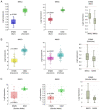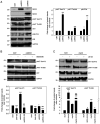Anti‑oncogenic and pro‑myogenic action of the MKK6/p38/AKT axis induced by targeting MEK/ERK in embryonal rhabdomyosarcoma
- PMID: 35801577
- PMCID: PMC9350981
- DOI: 10.3892/or.2022.8363
Anti‑oncogenic and pro‑myogenic action of the MKK6/p38/AKT axis induced by targeting MEK/ERK in embryonal rhabdomyosarcoma
Abstract
Insights into the molecular and cellular biology of embryonal rhabdomyosarcoma (ERMS), an aggressive paediatric tumour, are required in order to identify new targets for novel treatments that may benefit patients with this disease. The present study examined the functional effects of MKK3 and MKK6, two upstream kinases of p38, and found that the ectopic expression of MKK6 led to rapid p38 activation and the myogenic differentiation of ERMS cells, whereas MKK3 failed to induce differentiation, while maintaining the proliferation state. Myogenin and myosin heavy chain were induced in MKK6‑overexpressing ERMS cells and were inhibited by the p38 inhibitor, SB203580. The expression of Myc and ERK‑PO4 increased under the effect of SB203580, whereas it decreased in MKK6‑overexpressing cells. AKT activation was part of the myogenic program triggered by MKK6 overexpression alone. To the best of our knowledge, the present study demonstrates, for the first time, that the endogenous MKK6 pathway may be recovered by MEK/ERK inhibition (U0126 and trametinib) and that it concomitantly induces the reversal of the oncogenic pattern and the induction of the myogenic differentiation of ERMS cell lines. The effects of MEK/ERK inhibitors markedly increase the potential clinical applications in ERMS, particularly on account of the MEK inhibitor‑induced early MKK6/p38 axis activation and of their anti‑oncogenic effects. The findings presented herein lend further support to the antitumour effects of MKK6; MKK6 may thus represent a novel target for advanced personalised treatments against ERMS.
Keywords: MEK/ERK inhibitors; MKK6; Myc; embryonal rhabdomyosarcoma; p38.
Conflict of interest statement
The authors declare that they have no competing interests.
Figures










Similar articles
-
p21WAF1 expression induced by MEK/ERK pathway activation or inhibition correlates with growth arrest, myogenic differentiation and onco-phenotype reversal in rhabdomyosarcoma cells.Mol Cancer. 2005 Dec 13;4:41. doi: 10.1186/1476-4598-4-41. Mol Cancer. 2005. PMID: 16351709 Free PMC article.
-
MEK/ERK inhibitor U0126 affects in vitro and in vivo growth of embryonal rhabdomyosarcoma.Mol Cancer Ther. 2009 Mar;8(3):543-51. doi: 10.1158/1535-7163.MCT-08-0570. Epub 2009 Mar 3. Mol Cancer Ther. 2009. PMID: 19258428
-
Key role of MEK/ERK pathway in sustaining tumorigenicity and in vitro radioresistance of embryonal rhabdomyosarcoma stem-like cell population.Mol Cancer. 2016 Feb 20;15:16. doi: 10.1186/s12943-016-0501-y. Mol Cancer. 2016. PMID: 26897742 Free PMC article.
-
Down-regulation of c-Myc following MEK/ERK inhibition halts the expression of malignant phenotype in rhabdomyosarcoma and in non muscle-derived human tumors.Mol Cancer. 2006 Aug 9;5:31. doi: 10.1186/1476-4598-5-31. Mol Cancer. 2006. PMID: 16899113 Free PMC article.
-
Sequential activation of the MEK-extracellular signal-regulated kinase and MKK3/6-p38 mitogen-activated protein kinase pathways mediates oncogenic ras-induced premature senescence.Mol Cell Biol. 2002 May;22(10):3389-403. doi: 10.1128/MCB.22.10.3389-3403.2002. Mol Cell Biol. 2002. PMID: 11971971 Free PMC article.
Cited by
-
Antitumour effects of SFX-01 molecule in combination with ionizing radiation in preclinical and in vivo models of rhabdomyosarcoma.BMC Cancer. 2024 Jul 8;24(1):814. doi: 10.1186/s12885-024-12536-8. BMC Cancer. 2024. PMID: 38977944 Free PMC article.
-
PPM1G and its diagnostic, prognostic and therapeutic potential in HCC (Review).Int J Oncol. 2024 Nov;65(5):109. doi: 10.3892/ijo.2024.5697. Epub 2024 Sep 27. Int J Oncol. 2024. PMID: 39329206 Free PMC article. Review.
-
Hyperactive Akt1 Signaling Increases Tumor Progression and DNA Repair in Embryonal Rhabdomyosarcoma RD Line and Confers Susceptibility to Glycolysis and Mevalonate Pathway Inhibitors.Cells. 2022 Sep 14;11(18):2859. doi: 10.3390/cells11182859. Cells. 2022. PMID: 36139434 Free PMC article.
References
-
- Shern JF, Chen L, Chmielecki J, Wei JS, Patidar R, Rosenberg M, Ambrogio L, Auclair D, Wang J, Song YK, et al. Comprehensive genomic analysis of rhabdomyosarcoma reveals a landscape of alterations affecting a common genetic axis in fusion-positive and fusion-negative tumors. Cancer Discov. 2014;4:216–231. doi: 10.1158/2159-8290.CD-13-0639. - DOI - PMC - PubMed
-
- Felix CA, Kappel CC, Mitsudomi T, Nau MM, Tsokos M, Crouch GD, Nisen PD, Winick NJ, Helman LJ. Frequency and diversity of p53 mutations in childhood rhabdomyosarcoma. Cancer Res. 1992;52:2243–2247. - PubMed
-
- McCubrey JA, Steelman LS, Abrams SL, Lee JT, Chang F, Bertrand FE, Navolanic PM, Terrian DM, Franklin RA, D'Assoro AB, et al. Roles of the RAF/MEK/ERK and PI3K/PTEN/AKT pathways in malignant transformation and drug resistance. Adv Enzyme Regul. 2006;46:249–279. doi: 10.1016/j.advenzreg.2006.01.004. - DOI - PubMed
MeSH terms
Substances
LinkOut - more resources
Full Text Sources
Research Materials
Miscellaneous

